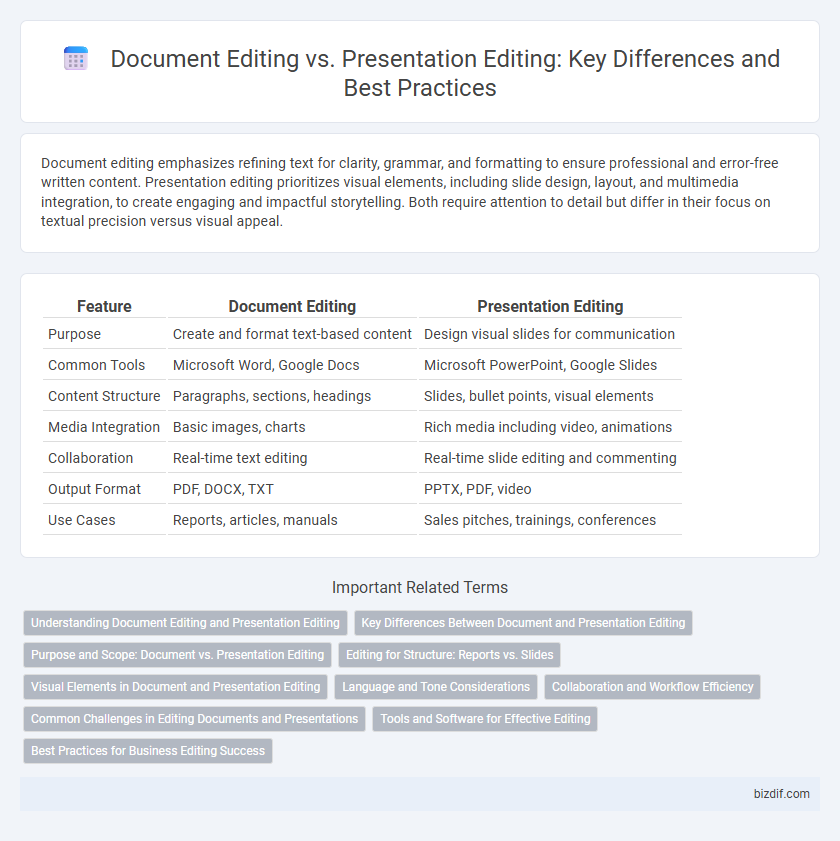Document editing emphasizes refining text for clarity, grammar, and formatting to ensure professional and error-free written content. Presentation editing prioritizes visual elements, including slide design, layout, and multimedia integration, to create engaging and impactful storytelling. Both require attention to detail but differ in their focus on textual precision versus visual appeal.
Table of Comparison
| Feature | Document Editing | Presentation Editing |
|---|---|---|
| Purpose | Create and format text-based content | Design visual slides for communication |
| Common Tools | Microsoft Word, Google Docs | Microsoft PowerPoint, Google Slides |
| Content Structure | Paragraphs, sections, headings | Slides, bullet points, visual elements |
| Media Integration | Basic images, charts | Rich media including video, animations |
| Collaboration | Real-time text editing | Real-time slide editing and commenting |
| Output Format | PDF, DOCX, TXT | PPTX, PDF, video |
| Use Cases | Reports, articles, manuals | Sales pitches, trainings, conferences |
Understanding Document Editing and Presentation Editing
Document editing involves refining textual content, improving grammar, clarity, and structure to enhance readability and coherence. Presentation editing focuses on visual elements such as slide design, layout consistency, and multimedia integration to effectively communicate key messages. Both require distinct skill sets tailored to their formats, ensuring content accuracy and audience engagement.
Key Differences Between Document and Presentation Editing
Document editing primarily involves refining text, grammar, structure, and formatting to ensure clarity and coherence, while presentation editing focuses on visual appeal, slide layout, and audience engagement through design elements. Document editors prioritize accuracy and readability, emphasizing paragraph flow and consistency, whereas presentation editors optimize multimedia integration, slide transitions, and concise bullet points for effective communication. Both require attention to detail, but presentation editing demands stronger emphasis on aesthetics and pacing to maintain viewer interest.
Purpose and Scope: Document vs. Presentation Editing
Document editing emphasizes clarity, coherence, and accuracy to enhance readability and ensure the text communicates detailed information effectively. Presentation editing focuses on visual impact and concise messaging to engage audiences and support oral delivery, incorporating design elements such as slides, charts, and graphics. The scope of document editing includes proofreading, restructuring, and fact-checking, while presentation editing prioritizes layout, visual hierarchy, and slide timing.
Editing for Structure: Reports vs. Slides
Editing for structure in reports involves organizing content into clear sections with headings, subheadings, and logical flow to enhance readability and comprehension. In contrast, presentation editing prioritizes slide layout, concise bullet points, and visual hierarchy to maintain audience engagement and clarity. Reports require adherence to formal formatting standards, while slides demand dynamic visual elements to support key messages effectively.
Visual Elements in Document and Presentation Editing
Document editing emphasizes clarity and consistency in textual formatting, incorporating visual elements like headers, bullet points, and charts to enhance readability and information hierarchy. Presentation editing prioritizes dynamic visual elements such as slides, animations, and multimedia integration to engage audiences and convey messages effectively. Both forms of editing require careful balance of typography, color schemes, and layout to optimize viewer comprehension and retention.
Language and Tone Considerations
Document editing prioritizes consistency in formal tone, clarity, and precision to ensure the text communicates ideas effectively and professionally. Presentation editing emphasizes engaging language and an approachable tone, adapting content to keep the audience's attention and enhance understanding through visual and verbal cues. Both require careful attention to audience expectations and purpose, but documents lean toward structured language while presentations favor conversational and dynamic expression.
Collaboration and Workflow Efficiency
Document editing enables real-time collaboration through tools like Track Changes and comments, streamlining feedback and version control. Presentation editing often incorporates collaborative features such as shared slide access and live annotations, enhancing teamwork during creation. Both editing types improve workflow efficiency by facilitating synchronous contributions and reducing the time spent on manual revisions.
Common Challenges in Editing Documents and Presentations
Document editing and presentation editing both face challenges such as maintaining clarity, ensuring content accuracy, and achieving consistent formatting. Documents often require precise grammar checks and citation verification, while presentations demand visual coherence, appropriate slide transitions, and effective use of multimedia elements. Balancing technical accuracy with audience engagement is crucial in both editing processes to produce polished, professional results.
Tools and Software for Effective Editing
Document editing primarily utilizes software like Microsoft Word, Google Docs, and Adobe Acrobat, which offer robust text formatting, track changes, and collaborative reviewing features. Presentation editing relies on tools such as Microsoft PowerPoint, Google Slides, and Keynote, emphasizing slide design, multimedia integration, and animation effects. Effective editing in both realms requires understanding the capabilities of these specialized tools to enhance content clarity, visual appeal, and audience engagement.
Best Practices for Business Editing Success
Document editing involves enhancing clarity, consistency, and grammar in written reports, proposals, and emails, ensuring professional communication. Presentation editing focuses on visual design, slide organization, and concise content to engage audiences effectively and support spoken narratives. Both require a keen understanding of business objectives and audience needs to maximize impact and achieve editing success.
Document editing vs Presentation editing Infographic

 bizdif.com
bizdif.com